VOLKSWAGEN T-ROC 2019 Repair Manual
Manufacturer: VOLKSWAGEN, Model Year: 2019, Model line: T-ROC, Model: VOLKSWAGEN T-ROC 2019Pages: 502, PDF Size: 8.58 MB
Page 61 of 502
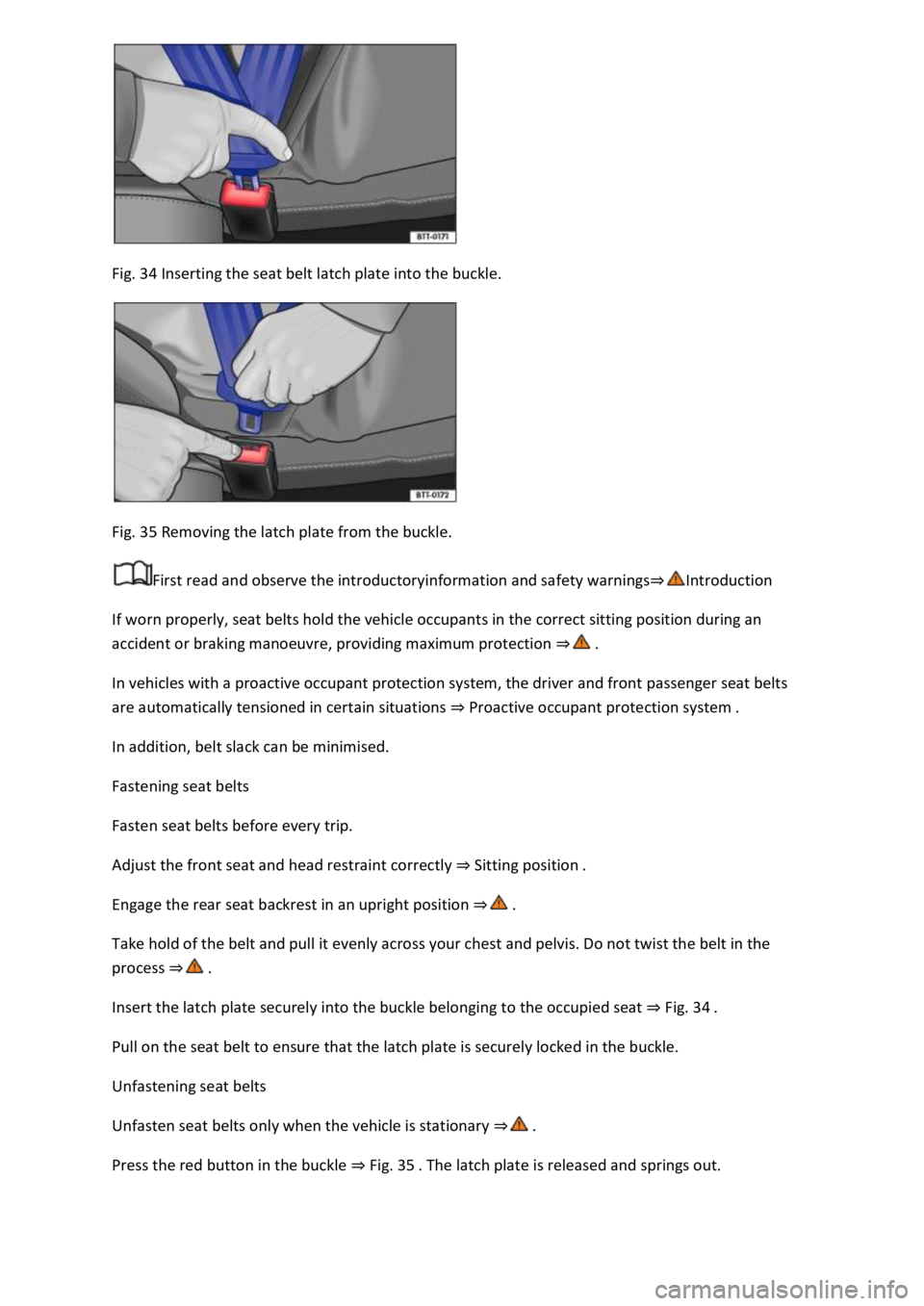
Fig. 34 Inserting the seat belt latch plate into the buckle.
Fig. 35 Removing the latch plate from the buckle.
First read and observe the introductoryinformation and safety warnings
If worn properly, seat belts hold the vehicle occupants in the correct sitting position during an
accident or braking manoeuvre, providing maximum protection
In vehicles with a proactive occupant protection system, the driver and front passenger seat belts
are automatically tensioned in certain situations Proactive occupant protection system
In addition, belt slack can be minimised.
Fastening seat belts
Fasten seat belts before every trip.
Adjust the front seat and head restraint correctly Sitting position
Engage the rear seat backrest in an upright position
Take hold of the belt and pull it evenly across your chest and pelvis. Do not twist the belt in the
process
Insert the latch plate securely into the buckle belonging to the occupied seat Fig. 34
Pull on the seat belt to ensure that the latch plate is securely locked in the buckle.
Unfastening seat belts
Unfasten seat belts only when the vehicle is stationary
Press the red button in the buckle Fig. 35 latch plate is released and springs out.
Page 62 of 502
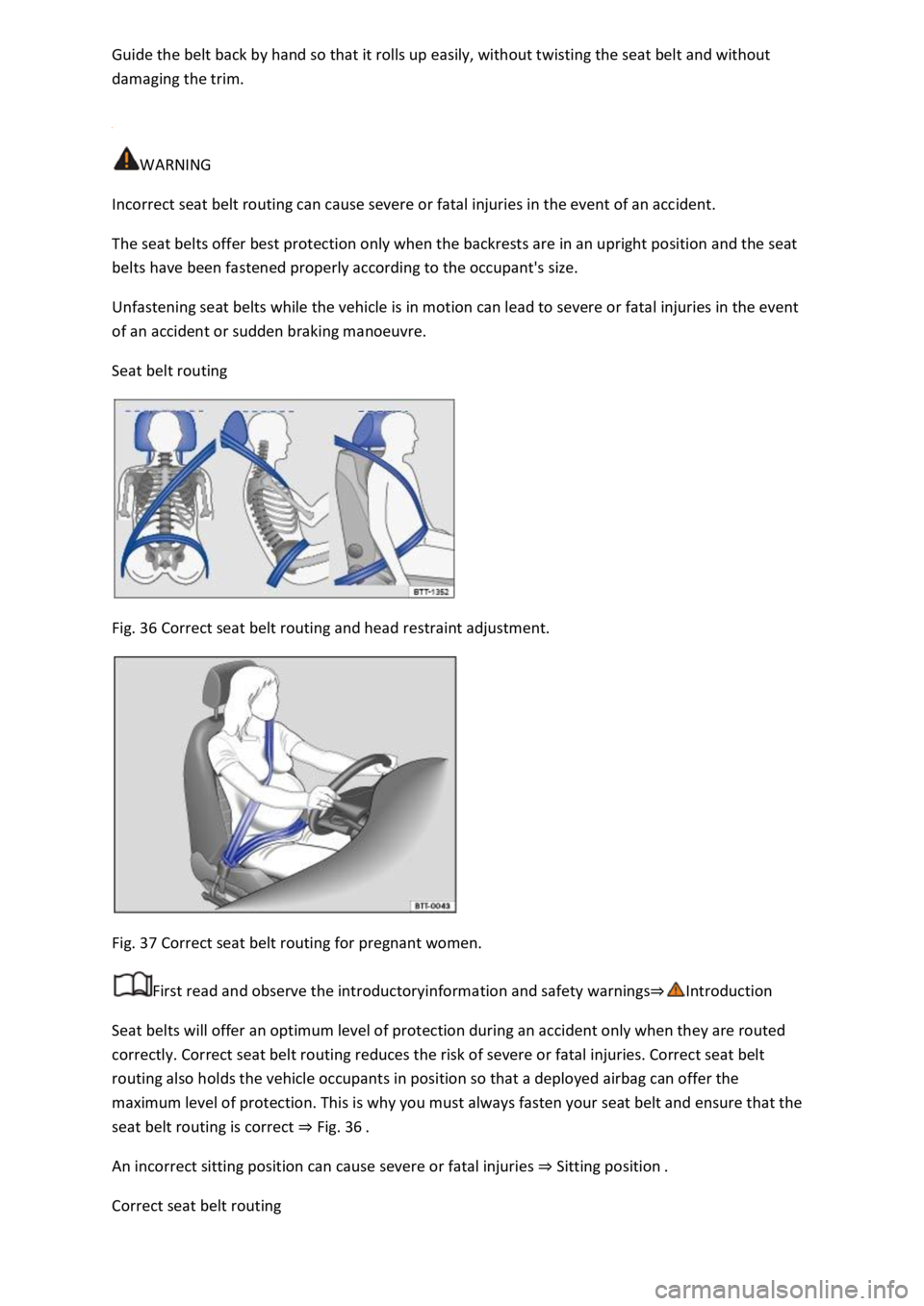
damaging the trim.
WARNING
Incorrect seat belt routing can cause severe or fatal injuries in the event of an accident.
The seat belts offer best protection only when the backrests are in an upright position and the seat
belts have been fastened properly according to the occupant's size.
Unfastening seat belts while the vehicle is in motion can lead to severe or fatal injuries in the event
of an accident or sudden braking manoeuvre.
Seat belt routing
Fig. 36 Correct seat belt routing and head restraint adjustment.
Fig. 37 Correct seat belt routing for pregnant women.
First read and observe the introductoryinformation and safety warnings
Seat belts will offer an optimum level of protection during an accident only when they are routed
correctly. Correct seat belt routing reduces the risk of severe or fatal injuries. Correct seat belt
routing also holds the vehicle occupants in position so that a deployed airbag can offer the
maximum level of protection. This is why you must always fasten your seat belt and ensure that the
seat belt routing is correct Fig. 36
An incorrect sitting position can cause severe or fatal injuries
Correct seat belt routing
Page 63 of 502

neck, over or under the arm or behind the back.
The lap part of the seat belt must always lie across the pelvis, never across the stomach.
The seat belt must always lie flat and snugly on the body. Tighten the belt slightly if necessary.
For pregnant women, the seat belt must be positioned evenly over the chest and as low as possible
over the pelvis. It must also lie flat so that no pressure is exerted on the abdomen this applies in
every stage of pregnancy Fig. 37
Adjusting seat belt routing to body size
The following equipment can be used to adjust the seat belt routing:
Seat belt height adjuster for the front seats Seat belt height adjuster
Height-adjustable front seats Sitting position
WARNING
Incorrect seat belt routing can cause severe injuries in the event of an accident or a sudden braking
or driving manoeuvre.
The seat belts offer best protection only when the backrests are in an upright position and the seat
belts have been fastened properly.
The seat belt itself or a loose seat belt can cause serious injuries if the seat belt shifts from harder
body parts in the direction of softer body parts (e.g. stomach).
The shoulder part of the seat belt must lie on the centre of the shoulder and never under the arm or
across the neck.
The seat belt must lie flat and snugly on the upper body.
The lap part of the seat belt must lie across the pelvis and never across the stomach. The seat belt
must lie flat and snugly on the pelvis. Tighten the belt slightly if necessary.
For pregnant women, the lap part of the seat belt must be as low as possible over the pelvis and lie
flat around the round stomach.
Do not twist the belt webbing while the seat belt is being worn.
Never hold the seat belt away from the body by hand.
The belt webbing should not lie over hard or fragile objects, such as glasses, pens or keys.
Never use seat belt clips, retaining rings or similar items to alter the seat belt routing.
If a person's physical build prevents them from routing the seat belt properly, contact a qualified
workshop to find out about any special modifications so that the seat belts and airbags can provide
Page 64 of 502
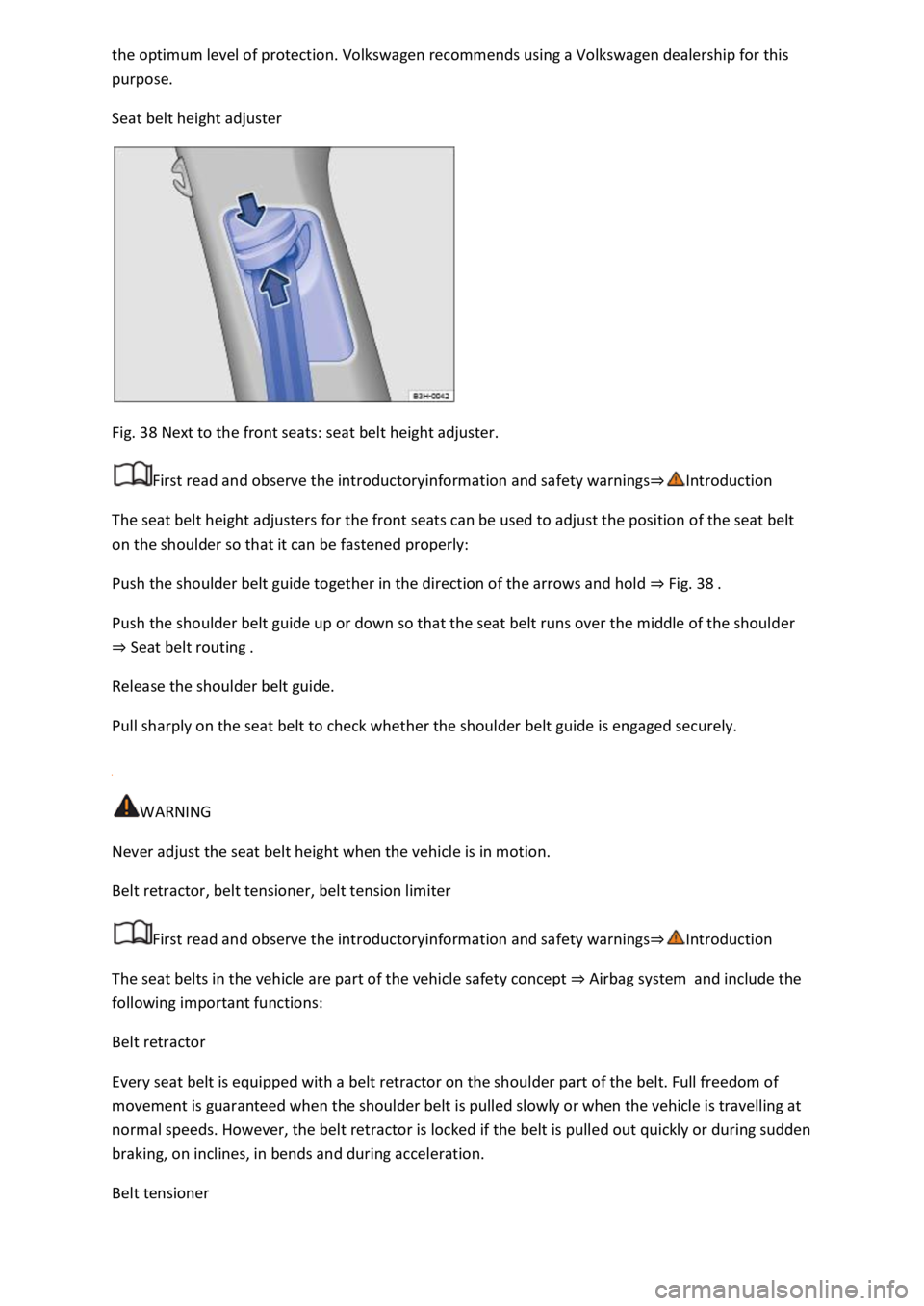
purpose.
Seat belt height adjuster
Fig. 38 Next to the front seats: seat belt height adjuster.
First read and observe the introductoryinformation and safety warnings
The seat belt height adjusters for the front seats can be used to adjust the position of the seat belt
on the shoulder so that it can be fastened properly:
Push the shoulder belt guide together in the direction of the arrows and hold Fig. 3
Push the shoulder belt guide up or down so that the seat belt runs over the middle of the shoulder
Seat belt routing
Release the shoulder belt guide.
Pull sharply on the seat belt to check whether the shoulder belt guide is engaged securely.
WARNING
Never adjust the seat belt height when the vehicle is in motion.
Belt retractor, belt tensioner, belt tension limiter
First read and observe the introductoryinformation and safety warnings
The seat belts in the vehicle are part of the vehicle safety concept Airbag systemand include the
following important functions:
Belt retractor
Every seat belt is equipped with a belt retractor on the shoulder part of the belt. Full freedom of
movement is guaranteed when the shoulder belt is pulled slowly or when the vehicle is travelling at
normal speeds. However, the belt retractor is locked if the belt is pulled out quickly or during sudden
braking, on inclines, in bends and during acceleration.
Belt tensioner
Page 65 of 502

They tighten the seat belts against the direction in which they are pulled. Any slack in the seat belt is
retracted, which can reduce the forward movement of the vehicle occupants and their movement in
the direction of the impact. The belt tensioner works together with the airbag system. If the vehicle
rolls over, the belt tensioners will not be activated if the side airbags are not triggered.
Fine dust may be produced when belt tensioners are triggered. This is quite normal and does not
mean there is a fire in the vehicle.
Belt tension limiter
The belt tension limiter reduces the pressure exerted by the seat belt on the body in an accident.
All safety regulations must be observed when the vehicle or components of the system are
scrapped. Qualified workshops are familiar with these regulations Service and disposal of belt
tensioners
Service and disposal of belt tensioners
First read and observe the introductoryinformation and safety warnings
Seat belts may become damaged during any work on the belt tensioners or while removing or
refitting any vehicle parts in conjunction with any other repair work. This damage will not always be
noticeable. The consequence may be that the belt tensioners could function incorrectly, or not
function at all, in the event of an accident.
Regulations must be observed to ensure that the effectiveness of the belt tensioner is not reduced
and that removed parts do not cause any injuries or environmental pollution. Qualified workshops
are familiar with these regulations.
WARNING
The risk of severe or fatal injuries may be increased if the seat belts, belt retractors and belt
tensioners are not used correctly or if they are repaired by a non-professional. As a result, the belt
tensioners may not be triggered when they should be, or they may be triggered unexpectedly.
Any repairs, adjustments or removal and refitting of parts in the belt tensioners or seat belts should
always be carried out by a qualified workshop and never by yourself Accessories, modifications,
Belt tensioners and belt retractors cannot be repaired. They must be replaced.
The airbag modules and belt tensioners may contain perchlorate. Observe the applicable legislation
regarding disposal.
Proactive occupant protection system
Page 66 of 502

The proactive occupant protection system is an assistance system that initiates measures to protect
vehicle occupants in dangerous situations. However, the system cannot prevent a collision.
The full range of functions of the proactive occupant protection system will be available only if the
function has been activated in the Infotainment system, no special driving profile has been selected
and there are no malfunctions Driving profile selecFunction
limitations
Basic functions
Depending on country-specific legal requirements and also on the vehicle equipment, the following
functions may be initiated, either individually or jointly, in critical situations (e.g. emergency braking
or in the case of oversteering or understeering) as of a speed of approximately 30 km/h (19 mph):
Reversible tensioning of the fastened front seat belts.
Depending on the critical driving situation, the seat belts can be tensioned separately or together.
Additional information for vehicles with an area monitoring system (Front Assist)
In vehicles fitted with the area monitoring system (Front Assist) Area monitoring system (Front
Assist)
limits. The system can trigger the proactive occupant protection system if it detects a probable
collision or initiates strong braking.
Function limitations
The proactive occupant protection system will not be available, or will be available only to a limited
extent, in the following situations:
If there is a fault in the ESC, belt tensioner Seat beltsor airbag control unit Airbag system
WARNING
The intelligent technology of the proactive occupant protection system cannot overcome the laws of
physics, and functions only within the limits of the system. Never let the extra convenience afforded
by the proactive occupant protection system tempt you into taking any risks when driving. The
system cannot prevent a collision. The system is not a substitute for the full concentration of the
driver.
Adapt your speed and distance from the vehicles ahead to suit visibility, weather, road and traffic
conditions.
The system cannot detect objects in all situations.
The proactive occupant protection system does not react to people, animals, objects crossing in
front of the vehicle, or objects which are hard to detect.
Page 67 of 502

cts such as safety barriers, tunnel entrances, heavy rain and ice can impair the
performance of the proactive occupant protection system and thus prevent it from detecting a
collision risk.
Incorrect system activation can occur.
WARNING
Accidents and injuries can occur if the driver is distracted.
Never change settings in the Infotainment system when the vehicle is in motion.
WARNING
Failure to observe illuminated warning lamps and text messages can lead to your vehicle breaking
down in traffic, and can cause accidents and serious injury.
Never ignore any illuminated warning lamps or text messages.
Stop the vehicle as soon as possible and when safe to do so.
NOTICE
Failure to observe illuminated indicator lamps and text messages can lead to your vehicle being
damaged.
Airbag system
Introduction
This chapter contains information on the followingsubjects:
Types of front passenger front airbag system
Indicator lamp
Description and function of the airbags
Front airbags
Switching the front passenger front airbag on and off
The vehicle is equipped with a front airbag for the driver and front passenger. The front airbags can
provide front seat occupants with additional chest and head protection if the seat, seat belts, head
restraints and, in the case of the driver, steering wheel are adjusted and used correctly. Airbags are
designed only for additional protection. The airbag system is not a substitute for the seat belts. Seats
belts must always be worn, even when the front seats are equipped with airbags.
Page 68 of 502

Never rely on the airbag system exclusively for your protection.
The airbag has merely a supportive function for your protection, even if it is triggered.
The airbag system offers the best level of protection and reduces the risk of injury when seat belts
are properly worn Seat belts
Before every trip, each vehicle occupant must adopt the correct sitting position, correctly fasten the
seat belt belonging to their seat and keep it fastened properly throughout the trip. This applies to all
vehicle occupants and also in urban traffic.
WARNING
The risk of injury increases if there are any objects located between the vehicle occupants and the
deployment area of the airbag when it is triggered. This will impinge on the deployment zone of the
airbag or the items will be flung against the body.
Never hold any objects in your hands or on your lap while the vehicle is in motion.
Never transport any objects on the front passenger seat. The objects could enter into the
deployment zone of the airbag during sudden braking or driving manoeuvres and then be flung
dangerously through the vehicle interior if the airbag is activated.
Vehicle occupants sitting on the front seats and rear outer seats must never carry any people, pets
or objects in the deployment zone between themselves and the airbags. Make sure that children and
passengers also keep to this rule.
WARNING
The airbag system can be triggered only once. The system will have to be replaced if the airbags have
been triggered.
Airbags that have been triggered, and any affected system parts, must immediately be replaced with
new parts that are approved by Volkswagen for the vehicle.
Repairs and modifications to your vehicle should be carried out only by a qualified workshop.
Qualified workshops have the necessary tools, diagnostic equipment, repair information and
qualified personnel.
Never use recycled airbag components or components that have been taken from end-of-life
vehicles in your vehicle.
Never alter any components of the airbag system.
WARNING
Page 69 of 502
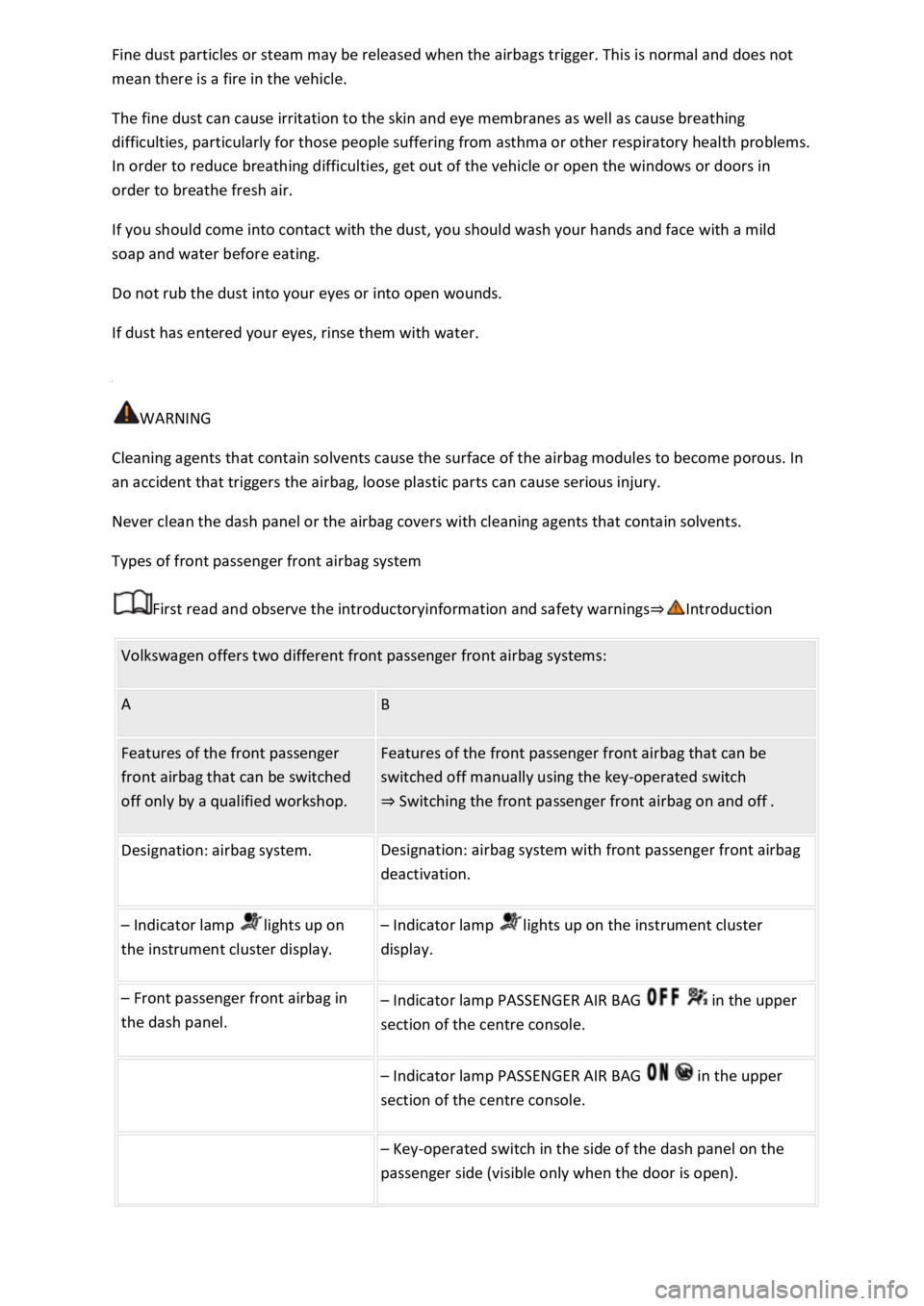
does not
mean there is a fire in the vehicle.
The fine dust can cause irritation to the skin and eye membranes as well as cause breathing
difficulties, particularly for those people suffering from asthma or other respiratory health problems.
In order to reduce breathing difficulties, get out of the vehicle or open the windows or doors in
order to breathe fresh air.
If you should come into contact with the dust, you should wash your hands and face with a mild
soap and water before eating.
Do not rub the dust into your eyes or into open wounds.
If dust has entered your eyes, rinse them with water.
WARNING
Cleaning agents that contain solvents cause the surface of the airbag modules to become porous. In
an accident that triggers the airbag, loose plastic parts can cause serious injury.
Never clean the dash panel or the airbag covers with cleaning agents that contain solvents.
Types of front passenger front airbag system
First read and observe the introductoryinformation and safety warnings
Volkswagen offers two different front passenger front airbag systems:
A B
Features of the front passenger
front airbag that can be switched
off only by a qualified workshop.
Features of the front passenger front airbag that can be
switched off manually using the key-operated switch
Switching the front passenger front airbag on and off.
Designation: airbag system. Designation: airbag system with front passenger front airbag
deactivation.
Indicator lamp lights up on
the instrument cluster display.
Indicator lamp lights up on the instrument cluster
display.
Front passenger front airbag in
the dash panel.
Indicator lamp PASSENGER AIR BAG in the upper
section of the centre console.
Indicator lamp PASSENGER AIR BAG in the upper
section of the centre console.
Key-operated switch in the side of the dash panel on the
passenger side (visible only when the door is open).
Page 70 of 502
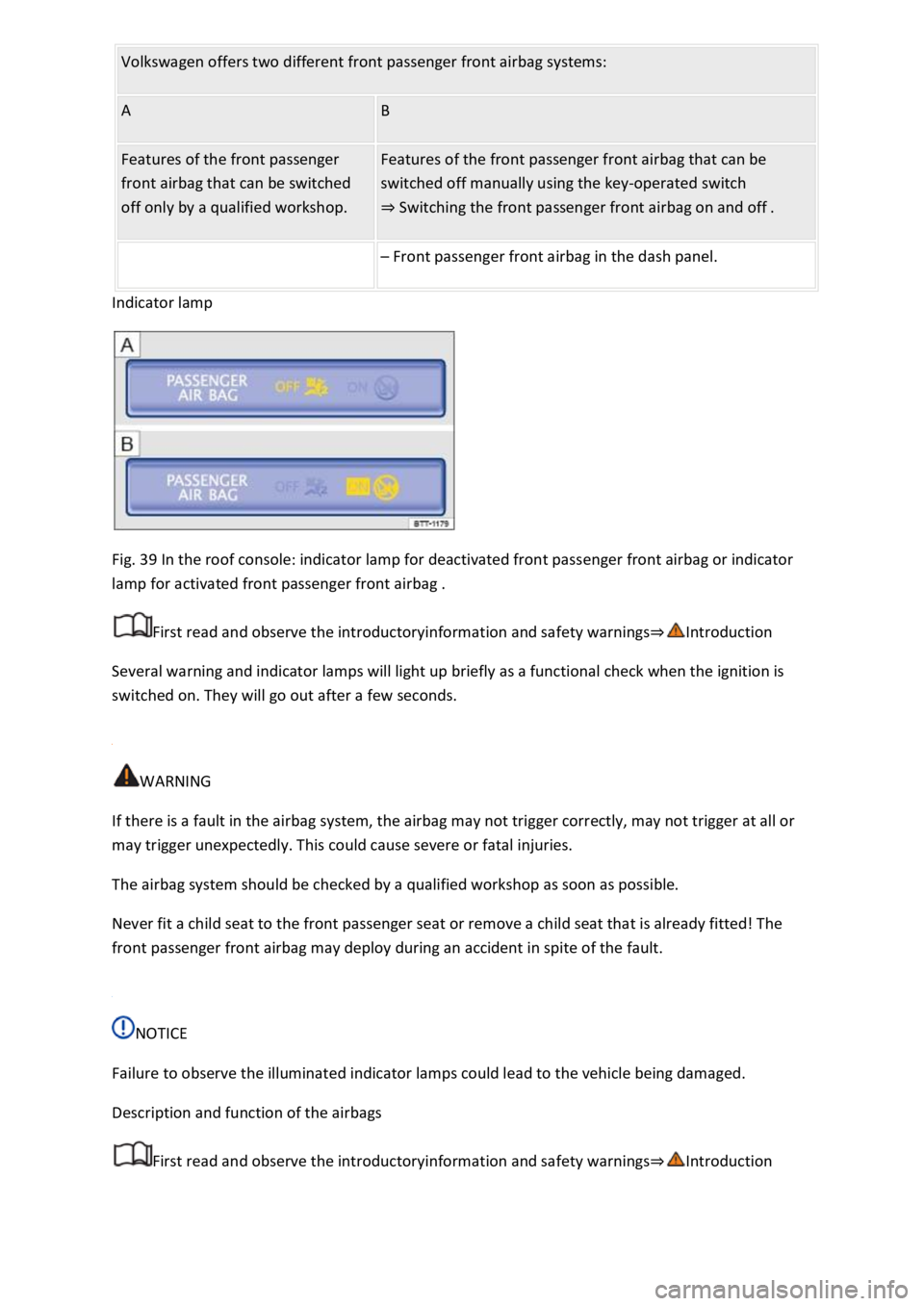
Fig. 39 In the roof console: indicator lamp for deactivated front passenger front airbag or indicator
lamp for activated front passenger front airbag .
First read and observe the introductoryinformation and safety warnings
Several warning and indicator lamps will light up briefly as a functional check when the ignition is
switched on. They will go out after a few seconds.
WARNING
If there is a fault in the airbag system, the airbag may not trigger correctly, may not trigger at all or
may trigger unexpectedly. This could cause severe or fatal injuries.
The airbag system should be checked by a qualified workshop as soon as possible.
Never fit a child seat to the front passenger seat or remove a child seat that is already fitted! The
front passenger front airbag may deploy during an accident in spite of the fault.
NOTICE
Failure to observe the illuminated indicator lamps could lead to the vehicle being damaged.
Description and function of the airbags
First read and observe the introductoryinformation and safety warnings